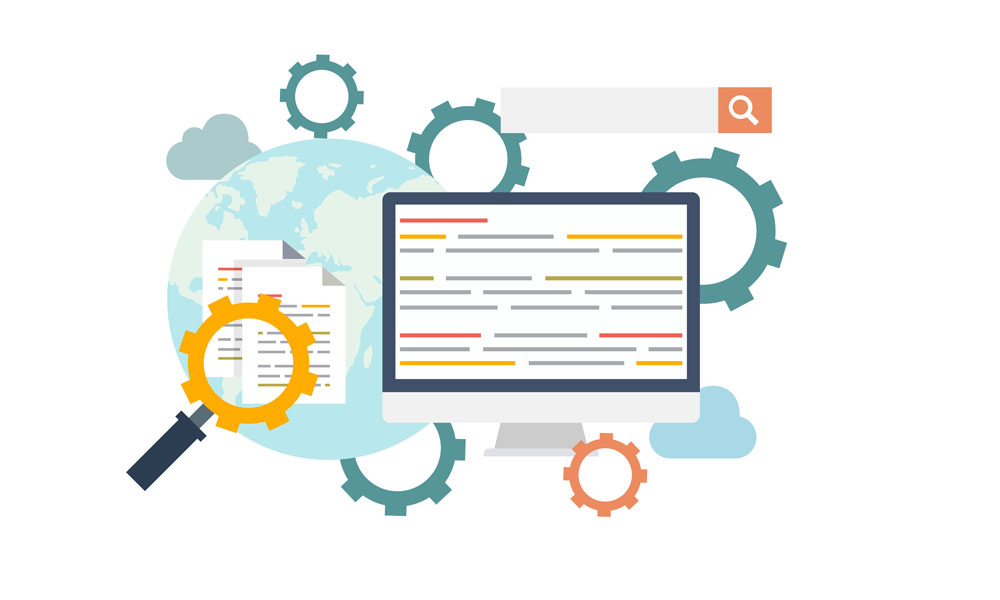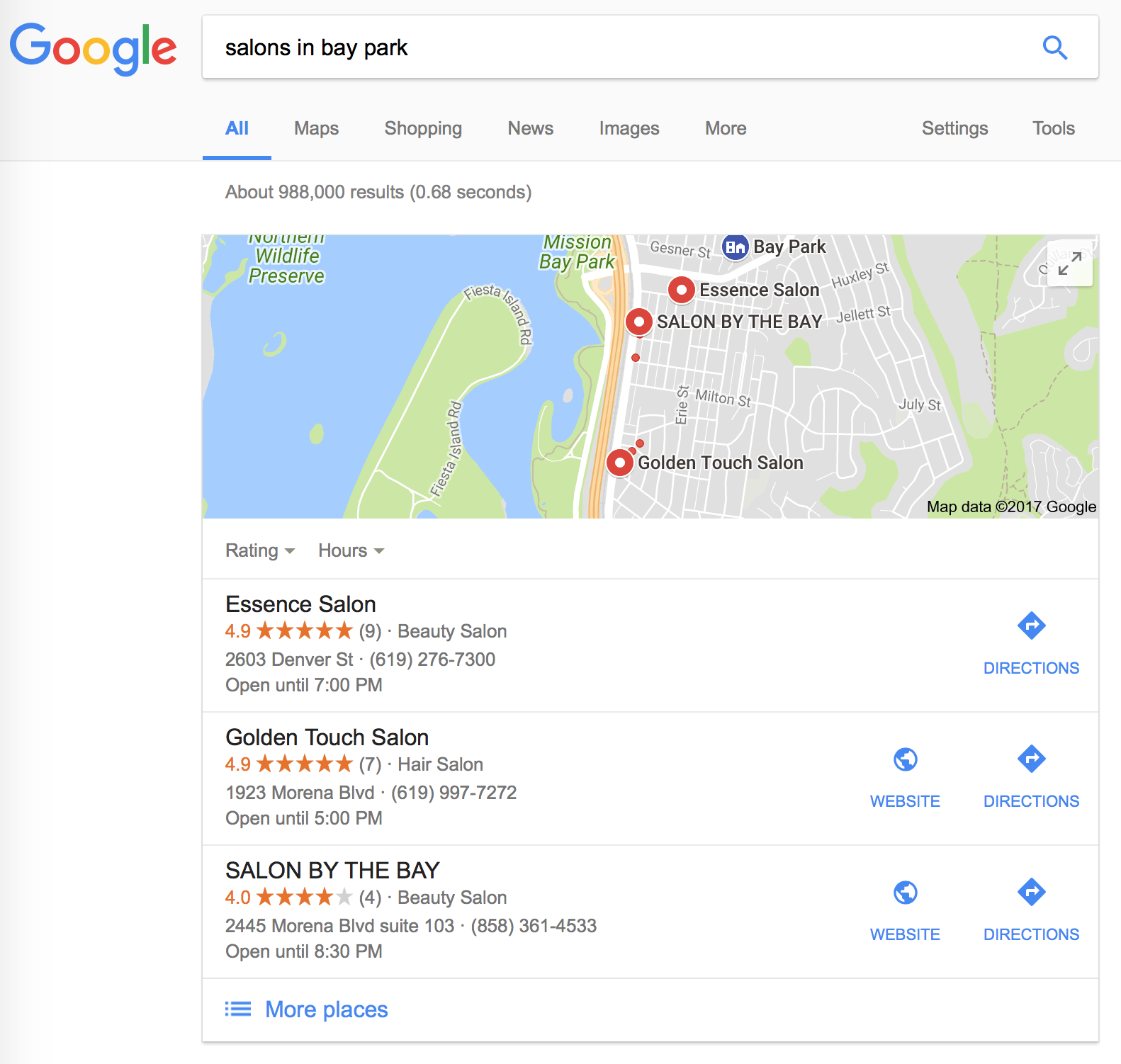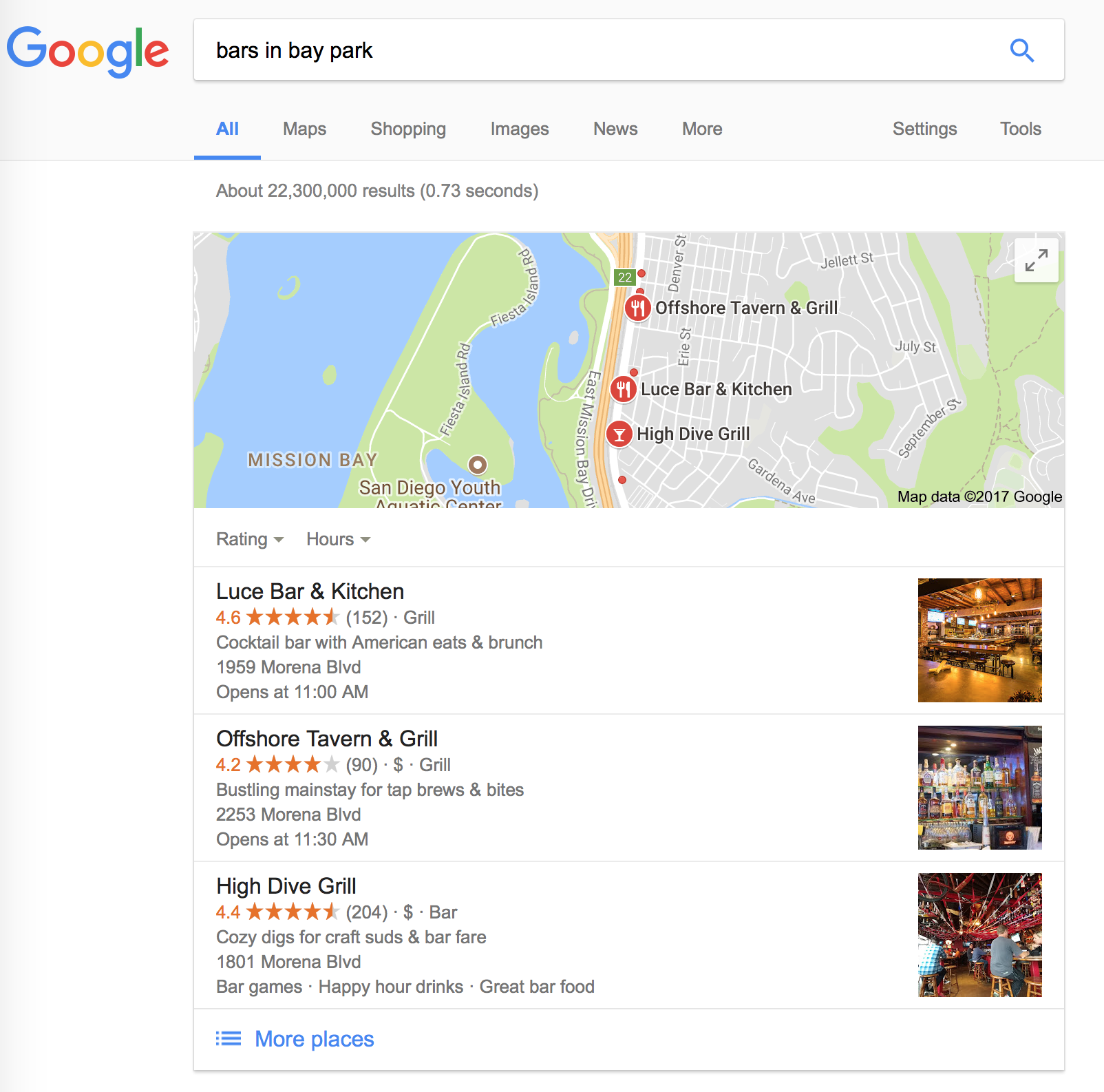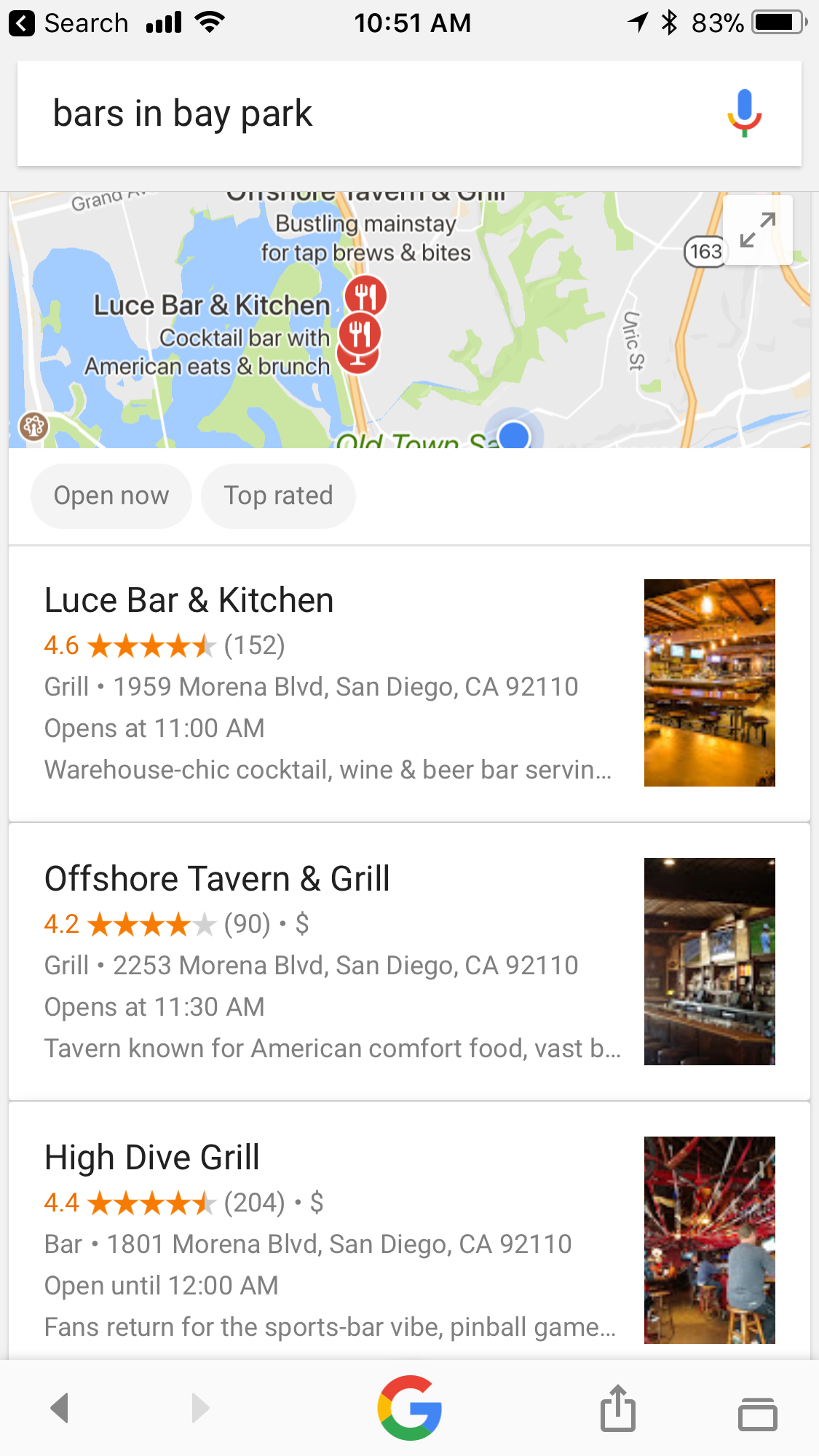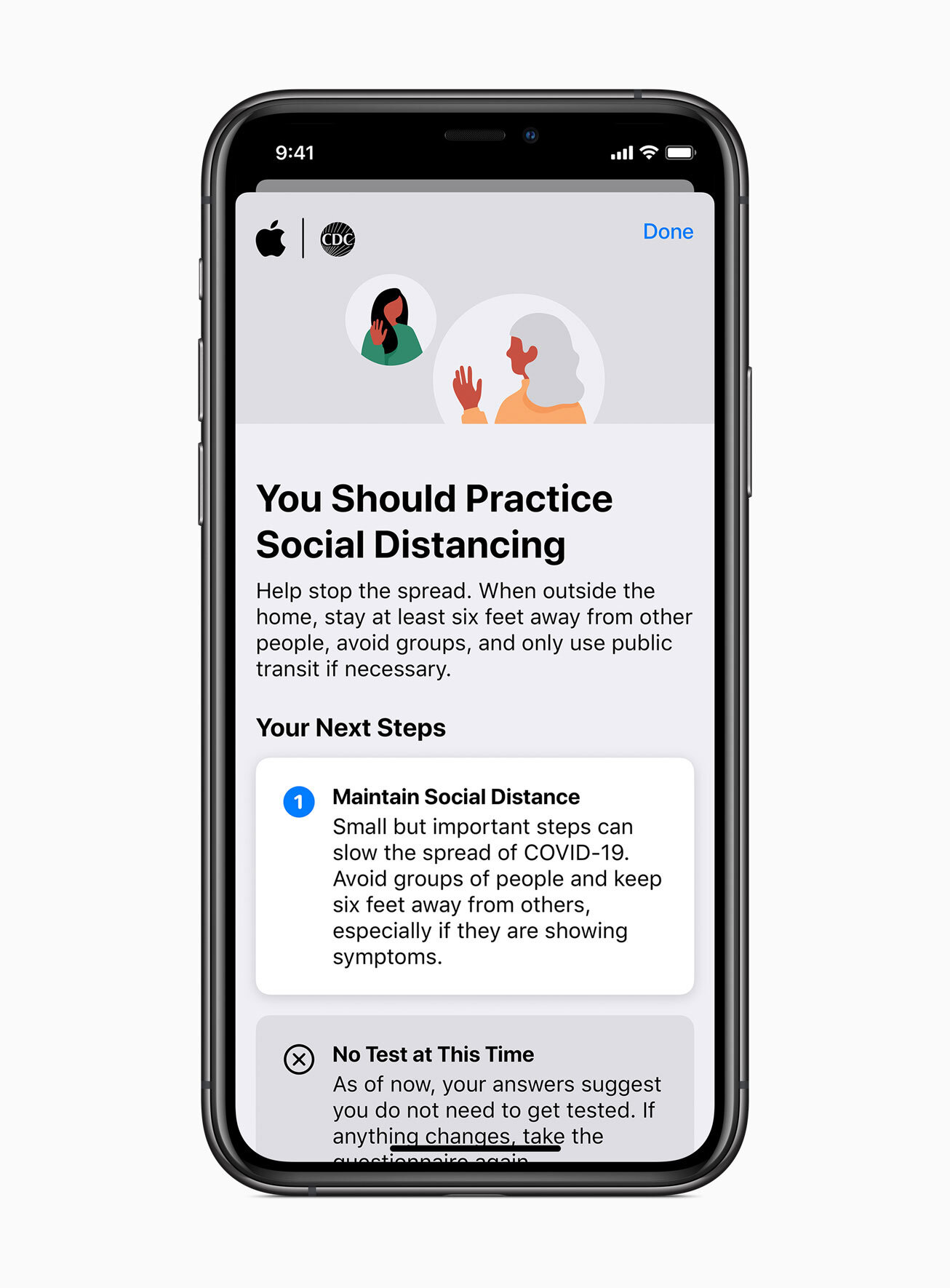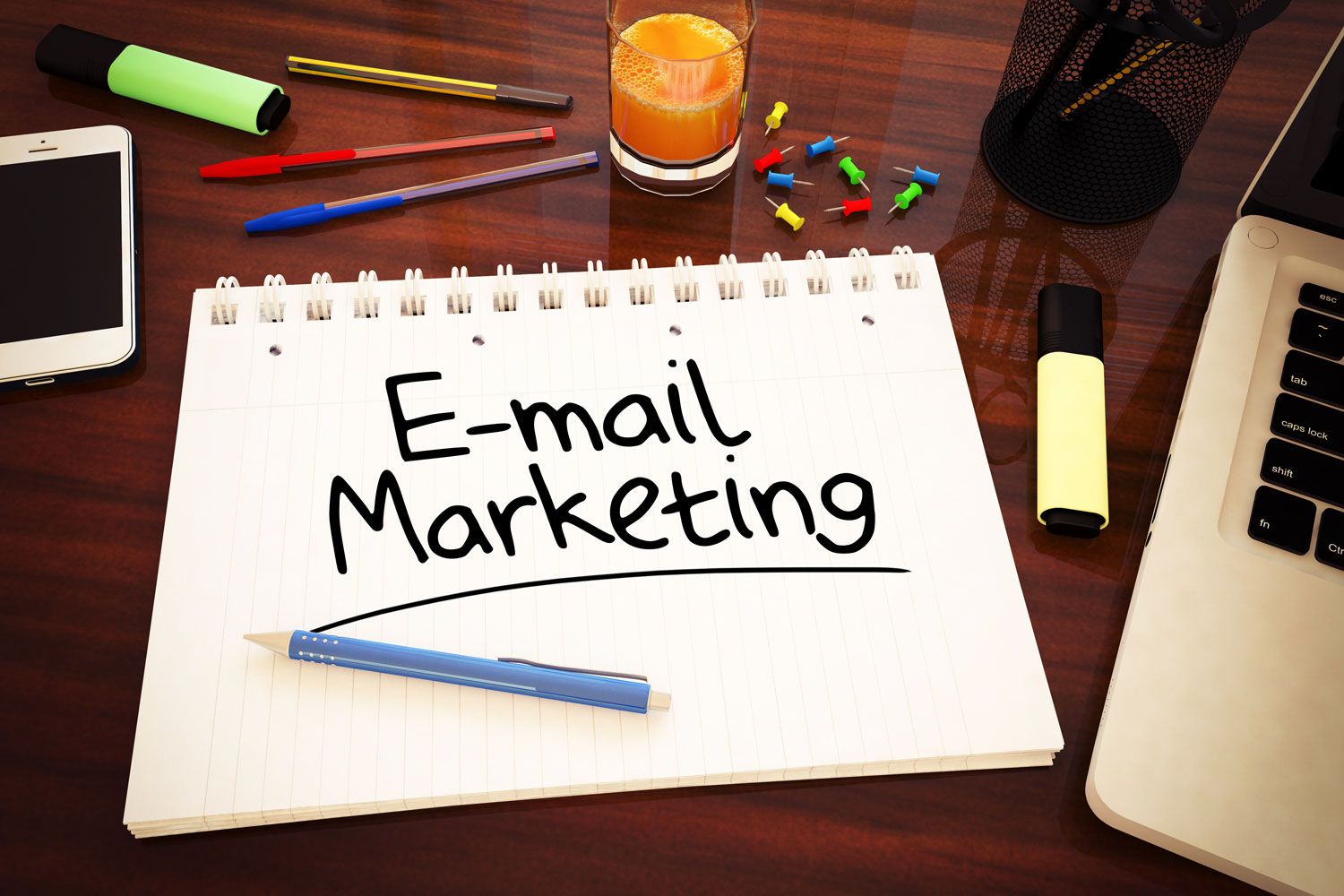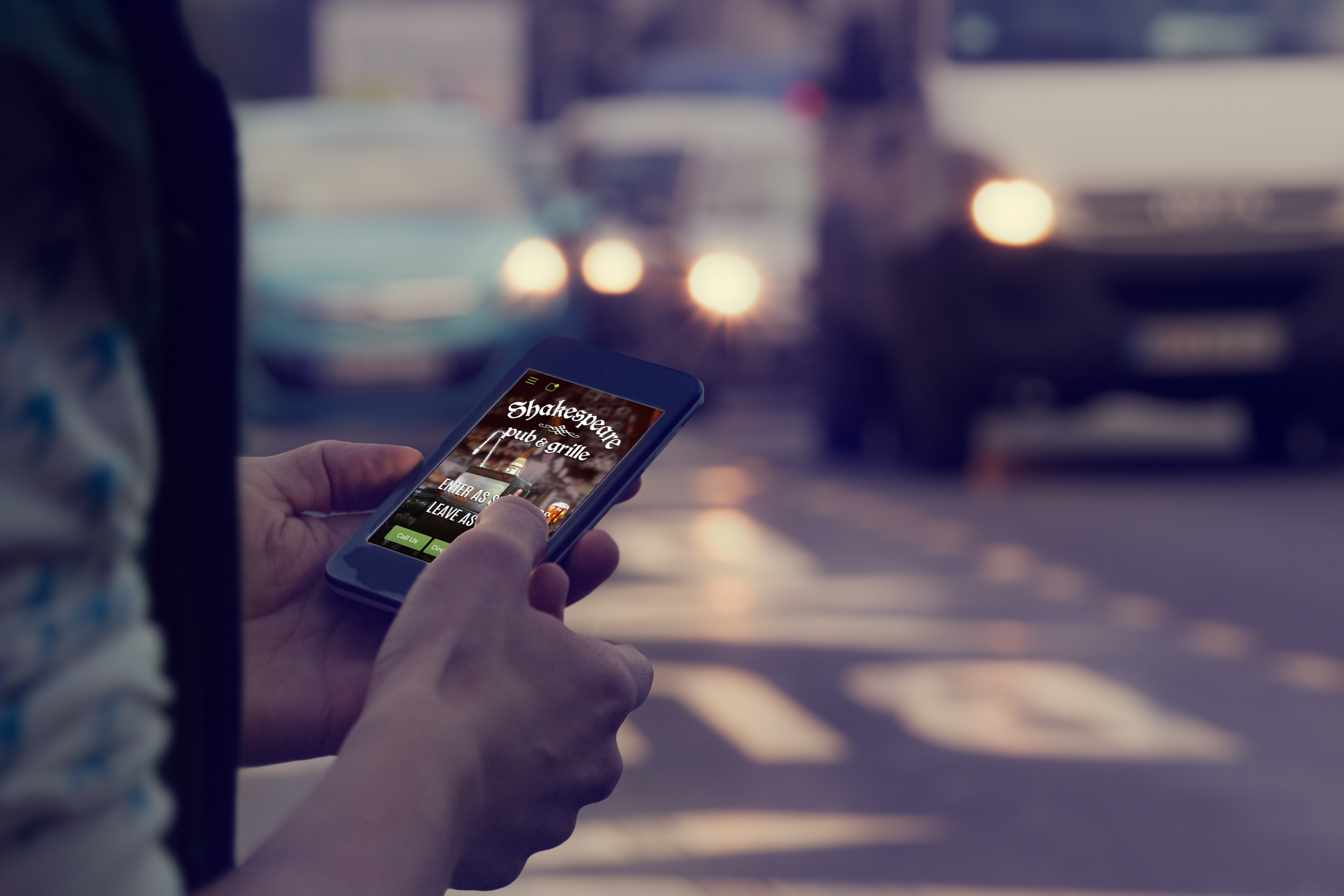
IT'S FAST MOVING BUT WE'LL KEEP YOU AHEAD OF THE CURVE
You Need To Be on This List! Get To Know The Google Local Pak!
The Local Pack is critically important to your small business' success and how users find you. So what is the local pack and why do I need to know about it? Let's "unpack" this Local Pack and find out how you can take advantage of it.
Have you ever heard of Google’s Local Pak – also referred to as the Map Pack or even the Snack Pack?
Even if you haven't heard of it you have certainly used it or seen it while searching Google for local businesses in your area. The Local Pack is critically important to your small business' success and how users find you. So what is the local pack and why do I need to know about it? Let's "unpack" this Local Pack and find out how you can take advantage of it.
1) What is the Google Local Pak?
The Local Pack is a section of Google’s search results that shows the local business related to your query. Whenever your query has local intent, Google will show three local businesses that might answer your query.
For example if I type into Google "bars in Bay Park" the Query shows three local bars in my area
A little while back these local packs were referred to as the 7-pack, as they displayed 7 of the most popular businesses in the area. In keeping up with growing mobile phone usage, Google cut down their 7-Pack down to just three results, along with some changes to the ways the algorithm ranks local results. Now when you search for local businesses, whether on desktop or phone, you will be shown the 3-Pack.
Even more recently, Google has started trialing a “paid spot” in their highly coveted 3-Pack. Google’s local 3-pack of organic listings may begin to show ads for certain searches, bringing the number of organic listings down to just 2. People are still debating whether this is the right move on Google’s part.
2) Why Should You Care About The Google Local Pack?
The Local 3-Pack appears in the #1 spot 93% of the time when a local search is performed – and 46% of all searches on Google are of this nature. This means that businesses that are optimized for a Google local search have a better chance of ranking at the top of the search results page, almost every single time. In other words, this is a major advantage for small businesses.
According to ThinkWithGoogle, 50% of consumers who conduct a local search on their smartphone visit a store within a day and 18% of those searches lead to a purchase within a day. What’s more, search queries with “near me” in the query have increased 34x since 2011 with the vast majority coming from mobile.
So, what does this mean for you? As a small business, you want to come up in local searches as often and as prominently as possible, and the way to do this is by appearing in the local pack. If you are ranked for Google’s holy trinity, your business will reap the benefits.
There are many advantages that come with the Local Pack, both online and offline. First, it will lead to more website traffic and better SEO outcomes. As Digital Coast Marketing states, “It is not uncommon for a small business that is listed on a few local listings without much traffic to beat out big chains that have a location in that area: that is how strong the effect of your presence on a listings site can be. This is because Google wants to give searchers a good experience by emphasizing the results that are truly local, and it uses these sites as a good way to determine that.”
Due to these online benefits, your business will get an increased amount of foot traffic, bringing new customers and increased revenue. Most people do not go beyond the Google’s first page when searching online, and in a local inquiry, this first page is centered on the 3-Pack. 78% of these local-mobile searches result in offline purchases, which means that every local search query in your area can bring in new customers and revenue.
In a Moz case study, they analyzed where users were clicking when they arrived at their local search results. The research found that:
- 44% of people clicked in the Local Pack
- 8% chose to load “more local results”
- 29% clicked on the organic listings
- 19% clicked on the paid results
3) How Can Your Business Rank For The Local Pack?
Google’s algorithm takes many factors into account when displaying their Local Pack – for the full rundown of ranking factors, check out Moz’ article. While their algorithm is extremely complicated and mystical, experts point to these three factors as crucial: Business Information, Website SEO, and Online reviews. As website SEO is a complete strategy in itself, we will be taking a closer look at business information and reviews as a way to rank in the Local Pack.
- UPDATE YOUR GOOGLE MY BUSINESS LISTING
Google is always looking to provide the best information and experience to their searchers. As a result, they want to make sure that any business they display in the search results “answers” the searchers query as good as possible. Key factors like proximity, category, and keywords will help them do so. And simply said, Google draws this information from all the Google My Business listings. If you have not set up a Google My Business listing for your small business yet, now is the time to do so (here is how). You are also missing out on all the rewards if you don’t have an optimized listing, so it is crucial that your profile is a 100% complete.
We’ve been talking a lot about the importance of reviews for small business recently. There are many benefits to generating reviews, but the one we haven’t mentioned yet is in relation to the Local Pack. Online reviews are a crucial part of the algorithm of the Local Pack and can make or break your chance of taking one of those coveted spots. Google takes into account review quantity, review velocity, review diversity and so on. Specifically Google reviews have a real effect on search rankings, and the listing with the most reviews often comes out as the winner.
Conversion Sciences did some interesting research into Google reviews and their effect on search engine visibility. This is what they found:
- The listings in the first three-pack have an average of 472% more reviews than the listings in the second three-pack.
- The top three local listings have more reviews than the next three results, nearly twice as often.
- 63% of the time, Google’s local three-pack contains the listing with the most reviews.
- A listing in the top three Google local results has an average of 7.62 reviews, compared to just 1.61 reviews in the second three-pack.
Not only do reviews work magic on Google’s algorithm, they also positively influence searchers decision-making process. Keep in mind that consumers who perform local searches are ready to buy and act quickly. Making it in the Local Pack is a tremendous business accomplishment, but it doesn’t end there. You are still competing with two other business in the Local Pack, that are probably similar in terms of product or service. How will the consumer make a decision here? You guessed it, the reviews! If you are the business with the most (positive) reviews, you will most likely beat out your competitors and win over that customer. The Moz study we referred to earlier found that reviews attracted the most clicks.
The takeaway? People AND Google love reviews. So once your Google My Business listing is optimized, you need to start raking in those reviews.
Conclusion:
Up until today, you might have never heard of the Google Local Pack – but you have definitely been exposed it is as a consumer. Now you can implement a Local Pack strategy that will also benefit you as a business owner. With your business listing and online reviews, you have powerful tools at your disposition to make the Local Pack work in your small business’ advantage. Google is about to transform your small business.
How Can You Help People Find Your Business? UPDATE YOUR GOOGLE MY BUSINESS
It is hard to run a business when people can't find you. One of the most important aspects to having a business is making it easy for people to discover you. Let's face it if we don't have clients we cannot sell products or services and none of us plan on shutting our doors anytime soon. I am going to share with you the first step on how to be found and the best part... it's free!
PROBLEM: GETTING FOUND
It is hard to run a business when people can't find you. One of the most important aspects to having a business is making it easy for people to discover you. Let's face it if we don't have clients we cannot sell products or services and none of us plan on shutting our doors anytime soon. I am going to share with you the first step on how to be found and the best part... it's free!
SOLUTION: GOOGLE MY BUSINESS
I know SEO is frightening and overwhelming and often times expensive however it is very necessary. There are lots of factors that go into SEO but we are going to focus on just one simple one today that will instantly pay dividends. GOOGLE MY BUSINESS
What is Google My Business?
Remember Google+? Well that is out and evolved into "Google My Business" which gives your business a powerful way to be found. Google My Business features a built in profile that appears to the right of a user’s search results and shows the following information:
- Business Name
- Business Address
- Business Telephone Number
- Business Logo
- Photographs of your Business
- One-click direction, call, and website buttons
- Popular times
- Hours of Operation
- Reviews
All of the above information is tracked by Google using their mighty analytics and gives the business an accurate pulse on how often customers are looking for them. Without this profile, a business is severely hampering its growth.
What is required to create a Google My Business?
Google requires that you have a brick and mortar business location. If you do not have one that is fine, there are many options out there.
You can locate a Post Office Box that does not use a “P.O. Box” in it’s address or you can see if a local office building in your area has a virtual tenant program. Google does not approve businesses for Google My Business profiles that use a P.O. Box in their address. Virtual tenant programs are widely available in many office buildings at all price points.
Let’s look at the steps it takes to get your Google My Business account set up!
Getting your Google My Business Account
Once on the Google My Business Page, select “Start Now” at the top right hand corner.
Next, you will be brought to a map page. This is where you enter in your business information.
Once all of your business information is filled in, press “Continue” wherein you will be prompted to verify your business information.
Google will then create your Google My Business profile and account. Once that is done, you will be asked to verify the address of your business so that they can send you the verification postcard.
You can verify later if you like, but I suggest that you verify your business as soon as possible because it will take a few business days (and you may need to submit for verification again in some cases) to complete.
After you verify your business address for the postcard, you can now access your Google My Business dashboard.
From the “Home” section of your dashboard, you can add your company logo, company photographs, edit your company info, as well as give you the ability to analyze insights for your business and look at customer reviews (once your business profile is verified).
Google has done many studies on these profiles and the people who are searching for your business have a higher chance of clicking on your website or calling your business if you have the logo and photographs of your company on your profile.
Under the “Info” section of your dashboard, you can update your company address, telephone number, business hours, website, etc. You can also unpublish your profile from this page, but why would you want to do that?
Under the “Photos” section of your dashboard you can manage the photos in your business profile. From the ones that are presented upon your search results or specific categories (team, exterior, and photos at work). Many customers use images of your business as an insight to the atmosphere and the quality of your services.
Ok, I am all set up, now what?
Now that you have your Google My Business profile up and running, you are one step closer to customers finding your business. Begin asking for reviews from your clients. Not all at once, but have a goal for you and your staff to get between 4-5 a week. Make a game out of it or reward your employees for spreading the word and getting reviews.
Consistent reviews are a great way for your organic SEO to begin to raise and with the consistent reviews, you will have proactive responses to both good and bad reviews.
Got it! Ask for reviews! But what if I am too busy to be that proactive?
Believe it or not, Google has an app that allows you to change your business information, review analytics, and proactively engage reviewers. It is available on both the Google Play and Apple iTunes Stores.
Conclusion:
Your Google My Business Page is now set up and your business is ready to roll! Growth and retention await you on your journey as a business.
Progressive Web Apps: The Next Mobile Experience?
You may not have heard of them yet, but Progressive Web Apps (PWA) are about to change the mobile landscape. While introduced in 2015 by Google, PWAs have gained popularity this year. So before it becomes all the rage, what are Progressive Web Apps exactly?
You may not have heard of them yet, but Progressive Web Apps (PWA) are about to change the mobile landscape. While introduced in 2015 by Google, PWAs have gained popularity this year. So before it becomes all the rage, what are Progressive Web Apps exactly?
What is a PWA?
In the most simple sense, PWAs are mobile apps delivered through the web. This technology allows PWAs to deliver an app-like experience on your browser. It feels like a native app due to the use of an app-shell that provides app-style navigations and gestures. Since progressive apps are built on the web, they are not tied to specific devices. A PWA displays seamlessly and identically on all devices, including desktop, mobile, tablet, or whatever comes next.
What’s more, service workers enable a Progressive Web App to load instantly, regardless of network quality. In other words, this web app is designed to work offline and in areas of low connectivity. With the help of pre-caching, it stays up-to-date, serving the user with the newest content upon launch. Similar to an app, the user is able to save the PWA to their home screen to access it at any time. Making it installable, without the hassle of downloading it from the app stores.
PWA vs. Native Mobile App
While native mobile apps provide the highest quality user experience, they come with friction for both the user and the developer. One of the biggest differences between PWAs and native apps is the presence of the “app store middleman”. For Progressive Web Apps, this middleman is completely taken out. For app developers, no app store means you are no longer restricted by iOS and Android’s rules and guidelines. A developer will not have to go through an approval process, allowing the app to be used as soon as it’s ready. There is also no need to manually update the app, as the revised app version will instantly and automatically be available to everyone.
From the perspective of the end user, they are able to access the PWA without having to download it from an app store. Instead, a PWA is linkable, which means anyone can launch the app straight from a URL. You can share it on social media, email, text message, online ad, or link it to a QR code, and the user will instantly be immersed into an app.
By removing all this friction, it will be much easier for users to have access to the app. As the diagram below shows, with every step of the native app download process, 20% of users are lost. Consumers find it tedious having to find the app in the app store, wait for it to download, and worry that it’ll use up all their storage space before they can start using the app. Because PWAs drastically reduce the amount of steps they need to take (essentially making it a one-step process), there is a much higher chance of people actually using the app. In fact, we use 4x as many websites as mobile apps, resulting in a much larger potential user base with a web based app.
Another major difference for app developers is that they will not have to adapt their app to iOS or Android. The fact that PWAs use web technology means they work cross-platform, on most browsers, taking the operating system out of the equation. You can build one Progressive Web App and it will look and perform the same across all devices. Users will have a cohesive experience on any device they choose to launch the app on.
Finally, PWAs are highly discoverable. This means they are easily identified by search engines, allowing them to come up in the search results just like any other web content. PWAs will be treated with traditional SEO, so it gets indexed for more than just the app name, but also the content within the app. It will not be treated as an app specifically, but as a piece of content that can “answer” someone’s “question.”
To put this into context, 60% of searches are now from mobile devices and this number continues to grow. People are actively using their mobile devices to find content, so imagine your PWA coming up in those search results. For example, someone might be looking for a salon in the area, so they use the Google search bar to start their inquiry. The search results will most likely show directories like Yelp and salon websites. If you own a salon business, your PWA could rank in these searches, driving customers straight from the search results to your app. This first touch is an opportunity to convert your customers. An app-like experience will allow customers to schedule a salon appointment from a UI built for mobile. It’s a seamless process starting with a web search and ending with a completed task in the app.
PWA vs. Mobile Website
PWAs are a hybrid of native apps and mobile websites, but how do they differ from responsive websites? Unlike “old school” mobile websites, PWAs are fast. Note that 53% of users will abandon a site if it takes longer than 3 seconds to load. PWAs load instantly, regardless of network state, and provide fast-to-respond interfaces. This eliminates their dependence on the network, as mobile websites do, ensuring an instant and reliable experience for users. A PWA also updates in the background, so users never need to wait for new content to load.
In addition, traditional mobile websites focus on static information, while PWAs are able to provide users with dynamic functionality. PWAs offer an immersive full-screen experience, allowing customers to place mobile food orders, participate in a loyalty program and contact a business. It can also re-engage users with web push notifications, similar to native push notifications.
Who Is Already Seeing Success?
To drive both traffic and re-engagement, cosmetics brand Lancôme launched a Progressive Web App to deliver a fast, app-like experience to their customers.
Lancôme saw mobile traffic exceed desktop traffic for the first time in 2016. Despite a growing number of mobile site visitors, mobile conversion rates didn’t match those for desktop. 38% of shopping carts on desktop led to orders, while the conversion rate for the mobile web was only 15%. These numbers revealed that customers were experiencing significant obstacles when trying to purchase via their mobile device.
At first, Lancôme considered an e-commerce app as the solution. However, they understood that an app only made sense for customers who visited regularly. Mobile shoppers would not return to an e-commerce app weekly, let alone daily, so they wouldn’t see the value in downloading a Lancôme app. The company wanted to build the right user experience on all of their devices. According to Google, “The company needed a fast-loading, compelling e-mobile experience, similar to what they could achieve with a native app—but one that was also discoverable and accessible to everyone via the mobile web”. Enter the Progressive Web App.
The results are staggering:
- 84% decrease in time until the page is interactive
- 17% increase in conversions
- 53% increase in mobile sessions on iOS
- 18% open rate on push notifications
- 8% of consumers who tap on a push notification make a purchase
- All told, the PWA has been a tremendous success, helping the beauty giant make great strides into the mobile revolution.
What does the future look like?
While native mobile apps are by no means going extinct, a PWA can provide the ideal solution for businesses looking to build a compelling and easily adoptable mobile experience for their customers. PWAs offer the best of both worlds, with all the shareability of the web and all the functionality of the native app. Applified Marketing Group has been working on web apps since 2011 and we are excited about this new technology. It finally gives us the ability to implement native features into our web apps. We will be part of the future of apps, where the mobile app and the mobile website become one.

